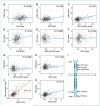Analytic variability in immunohistochemistry biomarker studies
- PMID: 20332259
- PMCID: PMC3891912
- DOI: 10.1158/1055-9965.EPI-10-0097
Analytic variability in immunohistochemistry biomarker studies
Abstract
Background: Despite the widespread use of immunohistochemistry (IHC), there are no standardization guidelines that control for antibody probe variability. Here we describe the effect of variable antibody reagents in the assessment of cancer-related biomarkers by IHC.
Methods: Estrogen receptor (ER), epidermal growth factor receptor (EGFR) 1, and human epidermal growth factor receptor 3 (HER3) were evaluated by quantitative immunofluorescence. Correlations between ER clones 1D5, SP1, F10, and ER60c, and EGFR monoclonal 31G7, 2-18C9, H11, and 15F8, and polyclonal 2232 antibodies were assessed in 642 breast cancer patients. HER3 was measured by RTJ1, RTJ2, SGP1, M7297, RB-9211, and C-17 antibodies in 42 lung cancer patients. Survival analysis was done with the use of multiple cutoff points to reveal any prognostic classification.
Results: All ER antibodies were tightly correlated (Pearson's r(2) = 0.94-0.96; P < 0.0001) and western blotting confirmed their specificity in MCF-7 and BT474 cells. All EGFR antibodies but 2232 yielded specific results in western blotting; however, only 31G7 and 2-18C9 were strongly associated (Pearson's r(2) = 0.61; P < 0.0001). HER3 staining was nonspecific and nonreproducible. High EGFR-expressing patients had a worse prognosis when EGFR was measured with H11 or 31G7 (log rank P = 0.015 and P = 0.06). There was no statistically significant correlation between survival and EGFR detected by 2-18C9, 15F8, or polyclonal 2232 antibodies.
Conclusions: Antibody validation is a critical analytic factor that regulates IHC readings in biomarker studies. Evaluation of IHC proficiency and quality control are key components toward IHC standardization.
Impact: This work highlights the importance of IHC standardization and could result in the improvement of clinically relevant IHC protocols.
Figures





Similar articles
-
Correlation of EGFR expression, gene copy number and clinicopathological status in NSCLC.Diagn Pathol. 2014 Sep 17;9:165. doi: 10.1186/s13000-014-0165-0. Diagn Pathol. 2014. PMID: 25227424 Free PMC article.
-
EGFR-immunohistochemistry in colorectal cancer and non-small cell lung cancer: comparison of 3 commercially available EGFR-antibodies.Acta Gastroenterol Belg. 2008 Apr-Jun;71(2):213-8. Acta Gastroenterol Belg. 2008. PMID: 18720932
-
Immunohistochemical detection using the new rabbit monoclonal antibody SP1 of estrogen receptor in breast cancer is superior to mouse monoclonal antibody 1D5 in predicting survival.J Clin Oncol. 2006 Dec 20;24(36):5637-44. doi: 10.1200/JCO.2005.05.4155. Epub 2006 Nov 20. J Clin Oncol. 2006. PMID: 17116944
-
EGF receptor expression, regulation, and function in breast cancer.Breast Cancer Res Treat. 1994 Jan;29(1):29-40. doi: 10.1007/BF00666179. Breast Cancer Res Treat. 1994. PMID: 8018962 Review.
-
Garbage in, garbage out: a critical evaluation of strategies used for validation of immunohistochemical biomarkers.Mol Oncol. 2014 Jun;8(4):783-98. doi: 10.1016/j.molonc.2014.03.008. Epub 2014 Mar 21. Mol Oncol. 2014. PMID: 24725481 Free PMC article. Review.
Cited by
-
MicroRNA let-7 Downregulates Ligand-Independent Estrogen Receptor-mediated Male-Predominant Pulmonary Fibrosis.Am J Respir Crit Care Med. 2019 Nov 15;200(10):1246-1257. doi: 10.1164/rccm.201903-0508OC. Am J Respir Crit Care Med. 2019. PMID: 31291549 Free PMC article.
-
EGFR protein expression in non-small cell lung cancer predicts response to an EGFR tyrosine kinase inhibitor--a novel antibody for immunohistochemistry or AQUA technology.Clin Cancer Res. 2011 Dec 15;17(24):7796-807. doi: 10.1158/1078-0432.CCR-11-0209. Epub 2011 Oct 12. Clin Cancer Res. 2011. PMID: 21994417 Free PMC article.
-
Empirical comparison of color normalization methods for epithelial-stromal classification in H and E images.J Pathol Inform. 2016 Apr 11;7:17. doi: 10.4103/2153-3539.179984. eCollection 2016. J Pathol Inform. 2016. PMID: 27141322 Free PMC article.
-
Flow-induced Shear Stress Confers Resistance to Carboplatin in an Adherent Three-Dimensional Model for Ovarian Cancer: A Role for EGFR-Targeted Photoimmunotherapy Informed by Physical Stress.J Clin Med. 2020 Mar 28;9(4):924. doi: 10.3390/jcm9040924. J Clin Med. 2020. PMID: 32231055 Free PMC article.
-
Epidermal growth factor receptor immunohistochemistry: new opportunities in metastatic colorectal cancer.J Transl Med. 2015 Jul 7;13:217. doi: 10.1186/s12967-015-0531-z. J Transl Med. 2015. PMID: 26149458 Free PMC article. Review.
References
-
- Hsi ED. A practical approach for evaluating new antibodies in the clinical immunohistochemistry laboratory. Archiv Pathol Lab Med. 2001;125:289–94. - PubMed
-
- Giltnane JM, Rimm DL. Technology insight: identification of biomarkers with tissue microarray technology. Nat Clin Pract. 2004;1:104–11. - PubMed
-
- Allred DC, Harvey JM, Berardo M, Clark GM. Prognostic and predictive factors in breast cancer by immunohistochemical analysis. Mod Pathol. 1998;11:155–68. - PubMed
-
- Yarden Y, Sliwkowski MX. Untangling the ErbB signalling network. Nat Rev Mol Cell Biol. 2001;2:127–37. - PubMed
-
- Scaltriti M, Baselga J. The epidermal growth factor receptor pathway: a model for targeted therapy. Clin Cancer Res. 2006;12:5268–72. - PubMed
Publication types
MeSH terms
Substances
Grants and funding
LinkOut - more resources
Full Text Sources
Other Literature Sources
Research Materials
Miscellaneous

